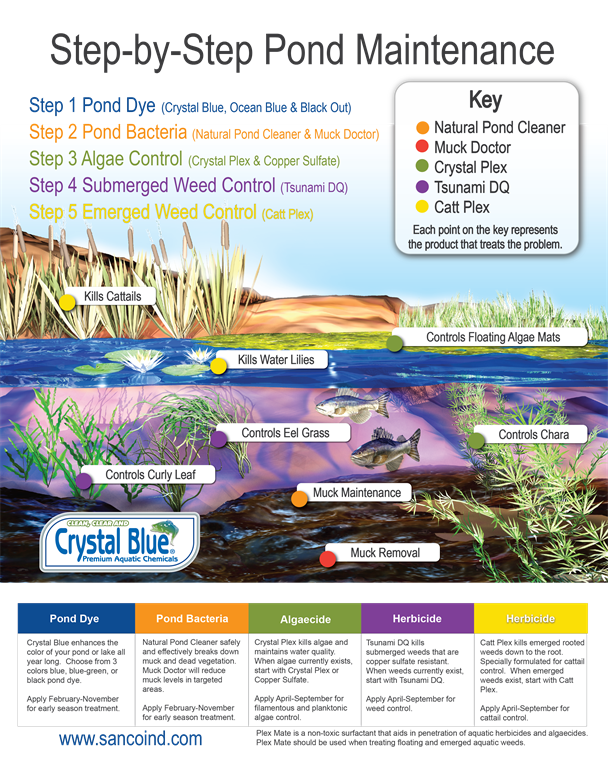I had an excellent question from a customer the other day that was the inspiration for this blog post. This pond owner had just acquired a property with a pond. His question was “Where do I start on the step-by-step pond maintenance guide? I already have algae and weeds…so do I treat the algae and weeds first or do I start at step 1 and add pond dye?” I must admit, when you are in this industry for this long, it becomes easy to glide over details that make a huge difference for a first-time pond owner. So, we apologize for over simplifying and we are here to guide you through our step-by-step program, no matter where you are in your pond management journey. After this blog, you should be able to know exactly where you need to start within our pond maintenance guide.
We provide a great Step-by-Step Pond Maintenance Program, but what happens when you pond problems aren’t so step-by-step or you acquire a pond midway through the season?

Take a look at the time of year and condition of the pond to figure out where you should start your pond maintenance program.
Spring- Pond is clear and ice is melted. Start at step 1, add pond dye and pond bacteria. These preventive maintenance steps are extremely important to combat the upcoming warmer temps, longer days, and algae waiting in the wings.
Spring- Ice is melted and some algae is present. Start at step 1, add pond dye and pond bacteria. You will not be treating for algae yet, even though it is present. The water temperatures need to be 50°F or warmer to treat algae successfully. By adding the dye and bacteria you will help slow existing algae. Monitor water temps closely and treat for algae as soon as temperatures are appropriate. Treat for algae several days after pond dye and pond bacteria application.
Summer- Pond is mostly clear with minimal growth. Start at step 1, add pond dye and pond bacteria. Identify your growth (weeds or algae). Treat growth several days after application of pond dye and pond bacteria. Only spray 1/2 your pond at a time when killing weeds and algae to avoid depleting the water of oxygen. If you have both weeds and algae, you can treat them at the same time.
Summer- Pond has excessive growth. Start at step 1, add pond dye and pond bacteria. Identify your growth (weeds or algae). Treat growth several days after application of pond dye and pond bacteria. Only spray 1/2 your pond at a time when killing weeds and algae to avoid depleting the water of oxygen. If you have both weeds and algae, you can treat them at the same time. When growth is excessive you will have to make repeated weekly applications to knock back the layers of growth. Alternate between each ½ until growth is under control. Continue to add pond dye and pond bacteria every month to help maintain the growth.
Fall- Pond is clear with minimal growth. Start at step 1, add pond dye and pond bacteria. Growth has most likely been maintained prior to your ownership of the pond or you are lucky . Identify your growth (weeds or algae). The water temperatures need to be 50°F or warmer to treat growth successfully. Treat growth several days after application of pond dye and pond bacteria. Only spray 1/2 your pond at a time when killing weeds and algae to avoid depleting the water of oxygen. If you have both weeds and algae, you can treat them at the same time.
Fall- Pond has excessive growth. Start at step 1, add pond dye and pond bacteria. Identify your growth (weeds or algae). The water temperatures need to be 50°F or warmer to treat growth successfully. If water temps are below recommended temperature or will be soon, you should wait to treat for weeds and algae in the spring. If water temperatures are going to remain warm, treat growth several days after application of pond dye and pond bacteria. Only spray 1/2 your pond at a time when killing weeds and algae to avoid depleting the water of oxygen. If you have both weeds and algae, you can treat them at the same time. When growth is excessive you will have to make repeated weekly applications to knock back the layers of growth. Alternate between each ½ until growth is under control.
For more information on pond maintenance contact the experts at Sanco.
